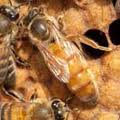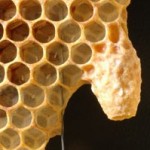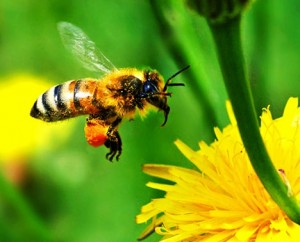 The queen is easily distinguished from other members of the colony as her body is normally much longer than either the drone’s or worker’s, especially during the main egg-laying period when her abdomen is greatly elongated. Her wings cover only about two-thirds of her abdomen, whereas the wings of both workers and drones nearly reach the tip of their abdomens when folded. A queen’s thorax is slightly larger than that of a worker and she has neither pollen baskets nor functioning wax glands. She has a stinger which is curved and longer than that of the worker, but it has fewer and shorter barbs. The queen can live for as long as 5 years but has an average productive life span of 2 to 3 years.
The queen is easily distinguished from other members of the colony as her body is normally much longer than either the drone’s or worker’s, especially during the main egg-laying period when her abdomen is greatly elongated. Her wings cover only about two-thirds of her abdomen, whereas the wings of both workers and drones nearly reach the tip of their abdomens when folded. A queen’s thorax is slightly larger than that of a worker and she has neither pollen baskets nor functioning wax glands. She has a stinger which is curved and longer than that of the worker, but it has fewer and shorter barbs. The queen can live for as long as 5 years but has an average productive life span of 2 to 3 years.
Each colony has only one queen, except for short periods during swarming preparations or supersedure (the act of replacing a failing queen). Because she is the only sexually developed female, her primary function is reproduction. She produces both fertilised and unfertilised eggs, the former producing female workers and the latter males or drones . Queens lay the greatest number of eggs in the spring and early summer and during peak production, queens may lay up to 2,000 eggs per day. They gradually cease laying eggs in mid autumn and produce few or no eggs until early the following spring, when the increased availability of pollen and nectar will be a signal to increase egg production again. One queen may produce up to 250,000 eggs per year and possibly more than a million in her lifetime.
The second major function of the queen is producing pheromones that act as a social ‘glue’ unifying and helping to give individual identity to a bee colony. One major pheromone, the ‘queen substance’, is produced by her mandibular glands, but others are also important. This queen substance is passed around the hive from the queen to worker bees as they feed and groom her and then from worker to worker bee. Members of the colony will accept and recognise each other as a result of this unique pheromone scent. The characteristics of the colony depend largely on the egg-laying and chemical production capabilities of the queen. Her genetic makeup, along with that of the drones she has mated with, contributes significantly to the quality, size, temperament and productivity of the colony.
Although it seems that the queen is in control of the colony it is actually the workers who collectively control the day-to-day tasks and functioning of the colony and ultimately decide on the fate of the queen. If they consider that she is any way deficient they will not hesitate to replace her, either starving her or attacking and killing her when they are sure they have a replacement lined up.
You may also find the following of interest:
 Life Cycle of the Honey Bee Queen
If the queen bee is accidentally killed, lost or removed from the hive the workers will sense her absence within minutes, by the reduction in her unique pheromones (queen substances).
Life Cycle of the Honey Bee Queen
If the queen bee is accidentally killed, lost or removed from the hive the workers will sense her absence within minutes, by the reduction in her unique pheromones (queen substances).

